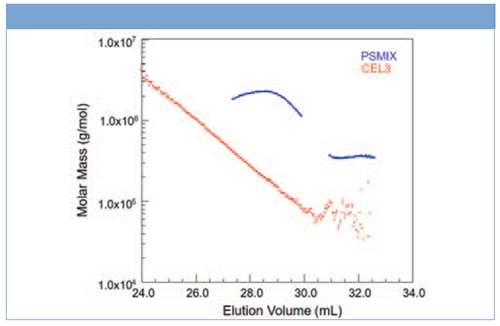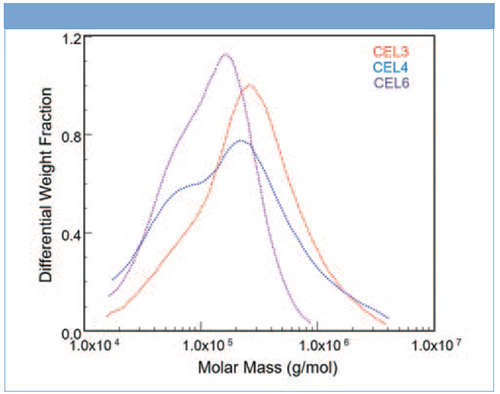Analysis of Cellulose Molecular Weight Distributions in DMAC
SEC-MALS analysis of cellulose provides absolute molar mass distributions to understand the impact of different extraction processes. The biopolymer is solubilized in DMAC, enabling liquid chromatography without degradation.
SEC-MALS analysis of cellulose provides absolute molar mass distributions to understand the impact of different extraction processes. The biopolymer is solubilized in DMAC, enabling liquid chromatography without degradation.
Cellulose, a biopolymer of great importance to the fibre and paper industries, is difficult to characterize because of its high molar mass. Its intractable nature means it cannot be dissolved in conventional solvents without chemical modification. With tedious effort, it can be modified so that it can be dissolved in an easy-to-use solvent like THF, but when the cellulose is so modified it is degraded and the analysis does not represent the source material.
Unmodified cellulose can be dissolved in dimethyl acetamide (DMAC) with LiCl added. The problem remains: how to characterize it without reference to column calibration standards that typically do not have the same conformation as cellulose. Absolute characterization is performed by combining multi-angle light scattering with size-exclusion chromatography (SEC-MALS) to determine molar mass, independently of elution standards.
Experimental Conditions
Separations were performed on a set of SDV-GPC columns in DMAC and LiCl. The separation columns were followed by the HPLC’s UV detector, a DAWN® MALS detector (Wyatt Technology), and an Optilab® differential refractive index (dRI) detector (Wyatt Technology).
Data collection and analysis were performed in the ASTRA® software (Wyatt Technology) using empirically determined differential refractive index increments (dn/dc). Polymer molar mass, M, was calculated at each elution volume using signals from the two detectors.
Results
Molar masses determined by MALS in Figure 1 follow the usual logarithmic variation with elution volume. For the sake of comparison, a run of two mixed polystyrene standards was overlaid in a plot of molar mass versus elution volume. As can be clearly seen, a calibration based on polystyrene standards would overestimate the molar mass by more than a factor of five. This discrepancy is usually a result of branching, typical for cellulose in the MW range of 105–106 and above.
Figure 1: Two narrow polystyrene standards and a cellulose. Note that at the same elution volume, the standard gives a molar mass 10 times larger than the cellulose value.

The technical process of extracting the cellulose from the wood pulp can have a profound effect on the molar mass distributions. Figure 2 shows the differences in molar mass distributions arising from different extraction processes. Only a MALS detector can reveal and quantify those differences and thereby MALS has become an important tool in optimizing the production processes for cellulose.
Figure 2: ASTRAs Differential Weight Distribution plot shows how different extraction processes create large variations in cellulose molar mass distributions.

Conclusions
The SEC-MALS results prove that the lengthy process of solubilizing the cellulose has been mastered, enabling the manufacturer to optimize the cellulose extraction process.

Wyatt Technology
6330 Hollister Avenue, Santa Barbara, California 93117, USA
Tel.: +1 (805) 681 9009
Website: www.wyatt.com

A Guide To Finding the Ideal Syringe and Needle
January 20th 2025Hamilton has produced a series of reference guides to assist science professionals in finding the best-suited products and configurations for their applications. The Syringe and Needle Reference Guide provides detailed information on Hamilton Company’s full portfolio of syringes and needles. Everything from cleaning and preventative maintenance to individual part numbers are available for review. It also includes selection charts to help you choose between syringe terminations like cemented needles and luer tips.
Oasis or Sand Dune? Isolation of Psychedelic Compounds
January 20th 2025Magic mushrooms, once taboo, have recently experienced a renaissance. This new awakening is partially due to new findings that indicate the effects of psilocybin, and its dephosphorylated cousin psilocin may produce long lasting results for patients who might be struggling with anxiety, depression, alcohol and drug abuse, and post-traumatic stress disorder. Hamilton Company has developed a methodology for the isolation and identification of 5 common psychedelic compounds used in the potential treatment of disease. The PRP-1 HPLC column resin remains stable in the harsh alkaline conditions ideal for better separations.
GPCRs – The Biological Traffic Modulator: Chromatographic Analysis of Peptides in the GI Tract
January 20th 2025The G protein-coupled receptors (GPCR) are found throughout the entire body and have shown significance in the development of new therapeutic treatments. Isolation of seven classic GRPC peptides initiating in the GI tract highlights the benefits of using the polymer-based PRP-3, a reversed-phase resin. The covalent bonds found in the PRP-3 exhibit advantageous interactions between the biological π bonds found in the peptides and the available aromatic benzyl rings of the resin.